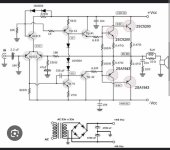The math quickly gets complicated. That would best be done with SPICE.
But you can certainly learn basic circuit analysis.
https://www.khanacademy.org/science/electrical-engineering/ee-circuit-analysis-topic
But you can certainly learn basic circuit analysis.
https://www.khanacademy.org/science/electrical-engineering/ee-circuit-analysis-topic
What math? All node voltages and part values are there. Ohms law and the fact that Vbe ~ 0.65V is all you need.
Jan
Jan
I don't know how to analyze a system that consists of npn and pnp transistors and also uses a symmetrical voltage source.
Can you teach me step by step
Samet
Can you teach me step by step
Samet
Start by breaking the circuit up into pieces.
You have two CCSes: One that feeds the differential pair at the input and one that feeds the bias spreader (three diodes in series) and VAS. There's the differential input stage and common emitter VAS (TIP41 with miller compensation, 330 pF). You then have an emitter follower driver feeding an emitter follower output stage with two devices in parallel per half. Now that you know which LEGO blocks are in the circuit, have a look at a textbook like Sedra/Smith "Microelectronic Circuits" and analyze the circuits.
I'm curious what you intend to get out of analyzing the circuit mathematically. You can certainly do that, but the math gets hairy pretty quickly. You'd get far more out of simulating the circuit.
Tom
You have two CCSes: One that feeds the differential pair at the input and one that feeds the bias spreader (three diodes in series) and VAS. There's the differential input stage and common emitter VAS (TIP41 with miller compensation, 330 pF). You then have an emitter follower driver feeding an emitter follower output stage with two devices in parallel per half. Now that you know which LEGO blocks are in the circuit, have a look at a textbook like Sedra/Smith "Microelectronic Circuits" and analyze the circuits.
I'm curious what you intend to get out of analyzing the circuit mathematically. You can certainly do that, but the math gets hairy pretty quickly. You'd get far more out of simulating the circuit.
Tom
I don't know how to analyze a system that consists of npn and pnp transistors and also uses a symmetrical voltage source.
Maybe this will help.
https://ecstudiosystems.com/discove...cs/amplifiers/complementary-symmetry-circuit/
https://www.picproje.org/index.php?topic=14793.0
The circuit diagram you shared is very similar to this project. You have to do this circuit and know that you can't learn anything if you don't do it.
The circuit diagram you shared is very similar to this project. You have to do this circuit and know that you can't learn anything if you don't do it.
- Home
- Amplifiers
- Chip Amps
- Ab class analysis
